During my recent encounter with this male Barn Owl at Farmington Bay I noticed something I’d never seen or even thought of before – manipulation of the facial disc that changes its shape and alters what we can see on the face of the bird.
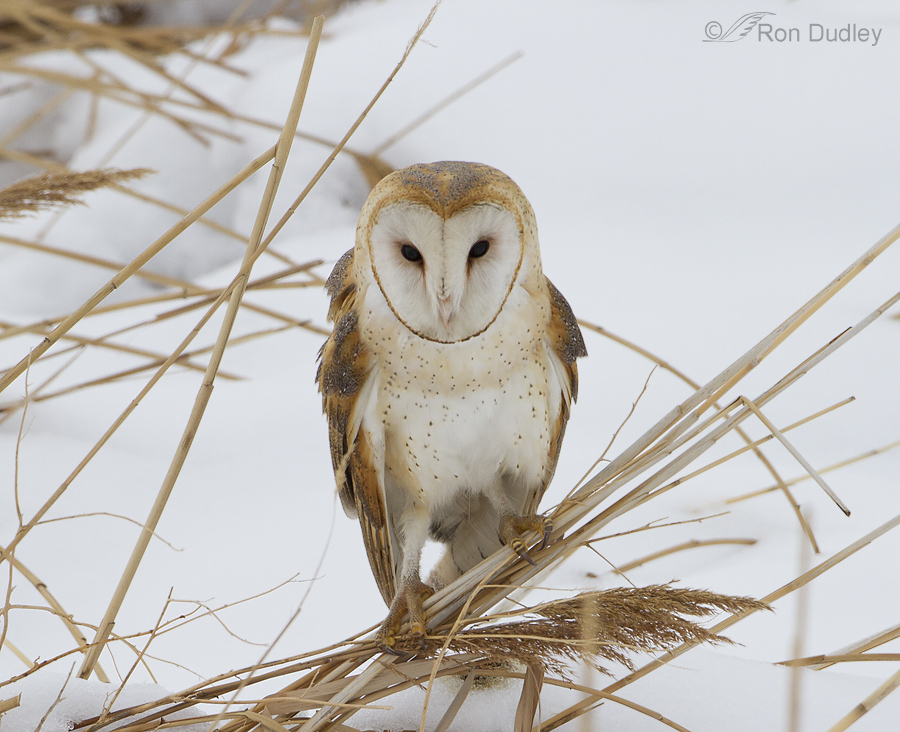
1/1600, f/7.1, ISO 640, Canon 7D, 500 f/4, not baited, set up or called in
This is the shape and configuration I’m used to seeing – the classic “heart shape” of the facial disc (ruff) of the Barn Owl. Notice that there’s an indistinct but noticeable dark line running down the midline from the forehead to the base of the bill. I guess I’ve always assumed that this was simply the color of the surface feathers there, matching the darker color of the surface feathers that outline the perimeter of the “heart”.
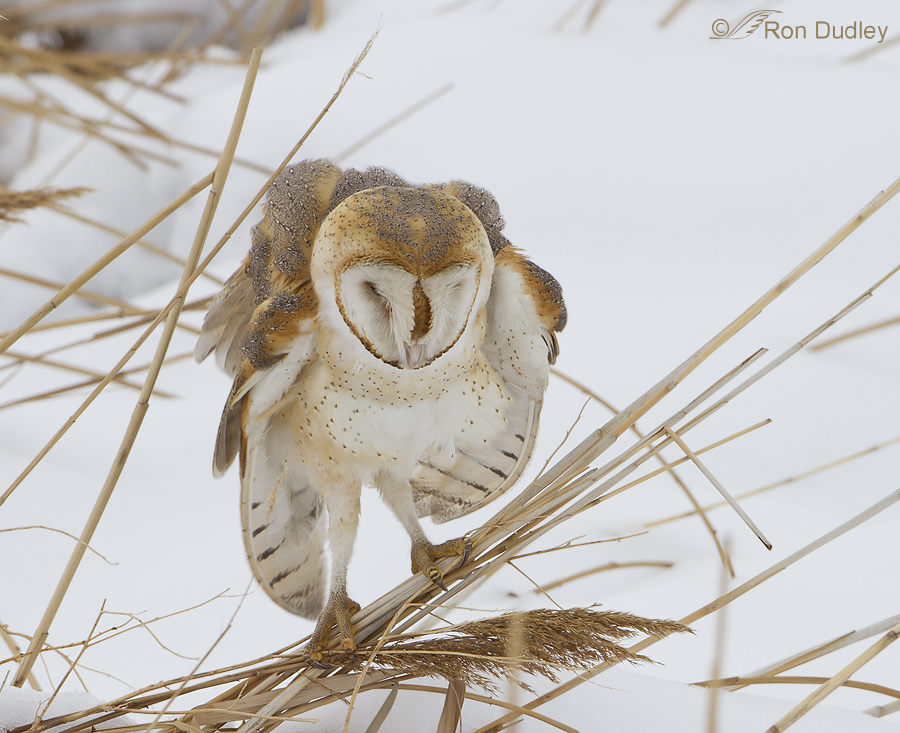
1/1600, f/7.1, ISO 640, Canon 7D, 500 f/4, not baited, set up or called in
But that’s not the case. While this owl was resting and grooming (rousing in this shot) it spent much of the time with the feathers along the midline of its facial disc pulled apart, revealing “something” dark underneath. I’ve spent a fair amount of time watching and photographing Barn Owls and this was something new to me that I was quite curious about.
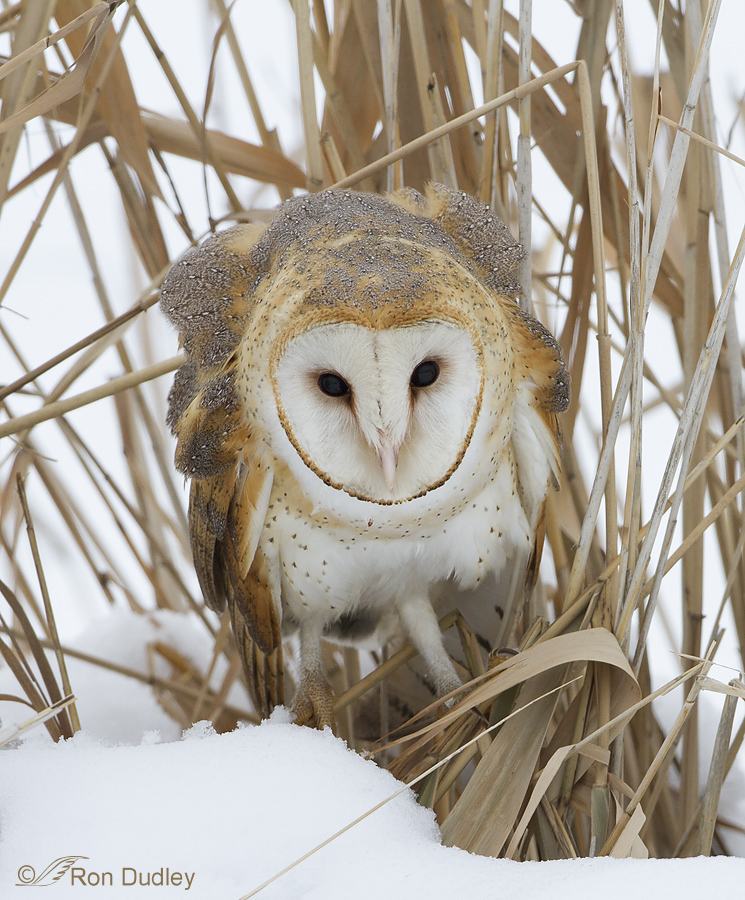
1/800, f/7.1, ISO 640, Canon 7D, 500 f/4, not baited, set up or called in
As the owl opened and closed the gap along the midline I began to realize that the dark vertical line that I’d never paid much attention to was actually not the color of the surface feathers but instead was the color from beneath showing through. But in my ignorance I still wasn’t sure what I was seeing under there – was it simply another layer of darker feathers? Perhaps at least the lower part of the dark color was the upper part of the bill that we normally don’t see? Or was it something else? Through my viewfinder I couldn’t see enough detail to figure it out.
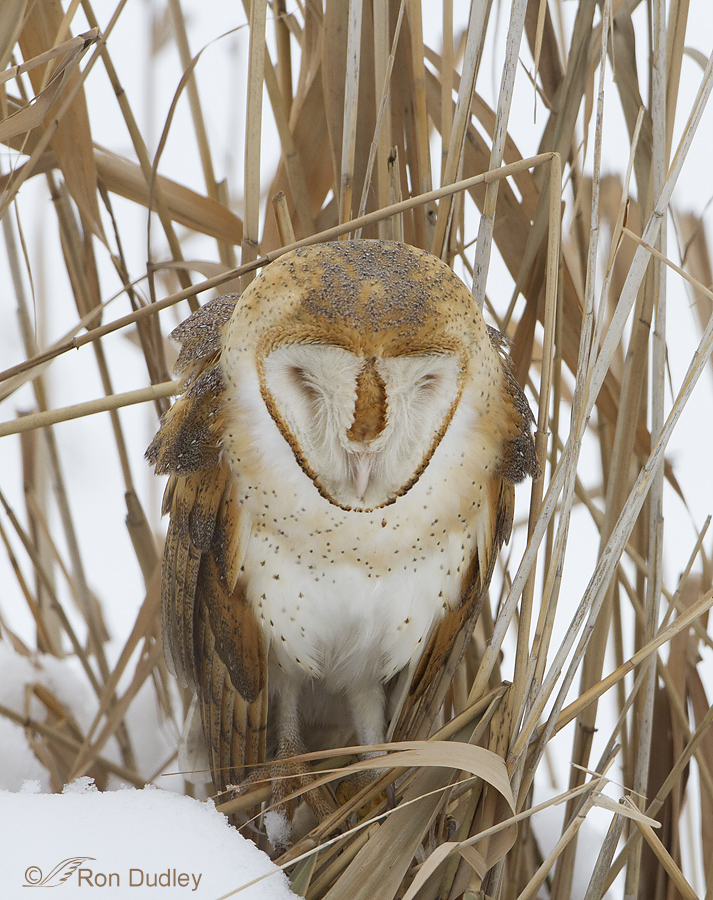
1/1000, f/7.1, ISO 640, Canon 7D, 500 f/4, not baited, set up or called in
But when I got home and blew the photos up on my screen it became apparent that what I was seeing under there was another layer of dark, rusty-red feathers that I didn’t even know existed (in that color).
1/1000, f/7.1, ISO 640, Canon 7D, 500 f/4, 1.4 tc not baited, set up or called in
I was quite close to this owl so for most of the shots I wasn’t using my teleconverter (tc) but I took a few with the tc attached to try to get as much detail of the facial disc as possible. This extreme crop shows the best detail I could get of the rusty-red plumage beneath the surface whites of the disc.
I’ve read that owls can manipulate the shape of their facial discs to better direct sounds to their ears under varying conditions. I find that fascinating and have attempted to research more information about it but have mostly come up empty.
I suspect that I’ve been pretty naïve about the sub-surface colors of the disc and that these owls may be capable of even more dramatic changes in disc shape than I’ve presented here. Rehabbers in particular may see these kinds of things regularly. If so, I’d be interested in any information or experiences you’d care to share about disc colors, function or shape changes.
Ron


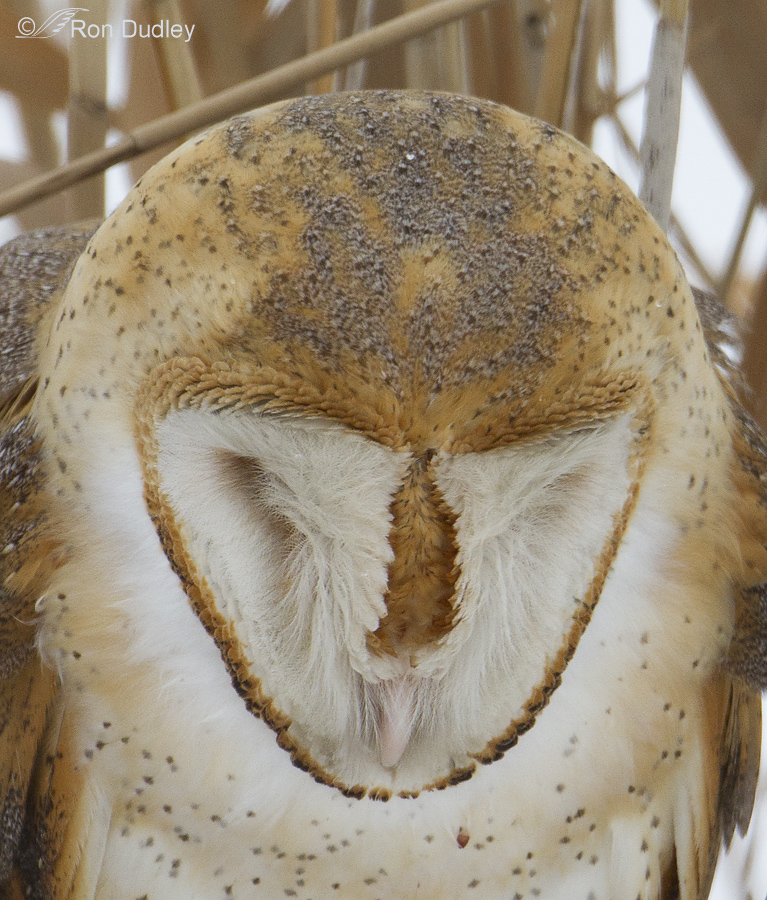
I just love your photography, especially when it contains a barn owl! I’ve never seen such a wide split in such detail before, Ron, although I’ve seen these splits before on barn owls. Thank you!
Sounds like you’re a true Barn Owl fan, Kathryn. You picked a great bird to love.
Fascinating. And incredible. Love the Evil Owl, and am so grateful to have had my first lesson of 2014 here this morning. Thank you all.
Happy New Year, Elephant’s Child – yours in Australia arrives so much earlier than ours does here. I’m just now (7:05 pm) beginning to hear the fireworks that I dread so much. Not much sleep tonight. I hope they freeze their butts off out there!
And if it is celebrated in a similar fashion over there, I hope their hangovers are monumental. Rather a lot of individuals were given a map to their car horns for Christmas, glued their fat fingers to it, and rode around the streets that way. Hiss and spit.
AHHH! Men!
LOVE those fireworks…NOT!!! Especially when my three rescues, 69, 90, 115 lbs of trembling dog flesh try to climb into my lap…and, if possible, onto my head and shoulders! YES! I hope they did freeze their butts off!
Happy New Year, everyone!
The Grinch
Happy New Year to you and everyone – from another Grinch!
I love these photos. Thank you. Also that gap shows how relaxed the owl is. The more relaxed the greater the opening. Ron, I was wondering if you ever published a book with some of your photos? I would love to get one.
Happy New Year!
Thanks, Debbie. Nope, no book. Probably won’t be, either. Too much work. I can barely keep up with the blog as it is…
These images are fantastic. I haven’t seen a Barn Owl manipulate its feathers like that! What a great thing to see first hand, Ron. Yet again, I’m envious, but at the same time, I’m thankful you captured the behavior in fashion. Keep teaching me things Ron! I’m loving it.
Here is another example of how some owls use the ability to manipulate their facial disks for yet a different purpose. Shape alteration. This owl (a Scops Owl) changes its shape much like our Screech owls will to change its overall shape to blend in with its surroundings. A form of camouflage. Most animals (including humans) use the shape of an object (other animal) to conclude what that animal is. Camouflage breaks up the shape and then also aids in blending into an environment. So if the shape is changed the animal may remain undetected. Then color is used to further identify.
http://youtu.be/APMheQP3pgU
Bill
A most interesting demonstration! Thanks for posting this.
The “evil owl” was amazing and quite humorous, Bill. Thanks very much for the link.
Thank you, Bryce. I learn things from your blog, too – regularly.
Fantastic shots as always! This is why I follow your blog, always something new to learn!
I just got home from work and saw these picture…WOW! Great pictures Ron….nice! I haven’t had a chance to read all the comments yet, but wanted to share my first impression.
Tim
note: I work full time Graveyard in the E.R.(Radiology)for the last 16 years….on the job 29. So I see Ron’s post just before I hit the hay!
Cool! I’ve never seen that movement before but it makes perfect sense. Another thing to know is that all the long feathers that make up the facial disks are very stiff. The tips make up the rusty heart and the white shafts form the white face. I mean STIFF, in remarkable contrast to the exquisite softness of the rest of the owl. The white part is not very dense, but the rusty edges are packed. What a miracle of evolution!
In Ron’s last photo of the series you can see that the facial disks are made of of layers of feathers. The outer layers are filoplumes with hardly any barbules. The rigid orange/golden fringes are formed by more contour like feathers but the tips have numerous short and therefore stiff barbules. Movement of these feathers create the lift of the upper filoplumes and expose the underlayer of feathering (contours) covering the upper beak and cere on the owl.
Bill
“Exquisite softness”, the perfect description of the soft subtleness so endearing in the coloration of these beautiful birds….
Great shots Ron. Love the detail of the Barn Owl feathers.
So much to learn, so each person’s contributions much appreciated as well as the beautiful photos. A Happy New Year to all.
absolutely fascinating!!!
Bill, Ron–I know one of an owl’s ears is higher than the other, but is the higher one always on the same side in all owls? In all of a particular kind of owl?
Good question, Patty. I don’t know…
Patty: The placement, size of opening and direction varies with different species but within a species the positioning is the same (allowing for gender differences in size of skull and age of individual). Its part of what makes them a specific species. (Allowing for abnormalities.)
Bill
THanks, Bill–happy New Year…
Fascinating!!!
That’s very cool. I certainly did not know that. Great images to show what’s really going on.
Thank you, Keith.
Owls have two facial disks that make up the “face” we commonly see. The value of them being able to manipulate the different disks is as you have suggested, to help direct sound to their different ear apertures. But lets back up a bit first to better understand the “system” for their hearing. I use to teach my students that the facial disks are like two satellite disks. The disks would receive the sound at two different times. The disk closest to the source first. An additional feature of the “system” is that their ears are located in asymmetrical positions on their skull and with some species facing in opposing directions. So one ear opening higher than the other and possibly one facing forward with the other facing backwards. (The human ear location is generally asymmetrical as well but not as noticeable as on the owl skull if the feathers are removed.) All this location info means the owl hears a sound in one ear before the other and their brain can process that information. The processing results in them figuring out if the sound is coming from in front or behind, above or below and from which side. With that information the bird turning more toward the sound will give them a better sense of the location of the source of the sound. Things that aid them in pin-pointing the sound location are moving their heads (disks as a whole) moving their head continually in a somewhat circular direction (triangulating the sound more so than the normal triangulation that occurs by simply having two discs, asymmetrical ear locations and opposing facing ear direction) and being able to further fine tune by changing the shape of the disks.
Barn owls are thought to have the best hearing of all the world’s owls (approx 133 species). Great Greys are said to be able to hear a mouse/vole moving under a foot of snow and are commonly seen hunting them in these conditions. Ron has mentioned several times that Barn Owls but even more specifically Great Greys) can die by a broken neck by diving head first into snow that has had a layer of it frozen.
http://i17.photobucket.com/albums/b64/smunster/Diagrams/OwlEarApetures.jpg
Bill
Bill, that was great information. I never knew the barn owls ears will ‘built’ like that!! Thanks for sharing.
Bill, I used to teach my zoology students about the asymmetrical ears of owls and how that system works so well for them. Fascinating stuff. Thank you for all the interesting and relevant information!
Here is a video of a Great Grey hunting in snow to demonstrate my last point about owl hearing and the risk to some of their hunting style in winter.
http://youtu.be/inoD5wxpko4
Bill
Interesting clip, Bill. It’s easy to see how they could break their neck in crusted snow when they go in head first.
That “rat” looks like a vole…
Here’s an example of more educational photography. Not as clear or beautiful as Ron’s. This is from a book written years ago by a dear friend Robert Nero, “The Great Grey Owl Phantom of the Northern Forest”. Unfortunately it is no longer in print. It helps put into perspective the size of the skull and its relationship to the facial disks and head plumage.
http://i17.photobucket.com/albums/b64/smunster/Diagrams/GreatGreyHead001.jpg
Bill
Great shots as usual!! I knew the face feathers met in the middle. I had no idea what was underneath in the middle. I’m sure somebody on one of the live owl cams I used to watch knew and posted. I just don’t remember. They are such fascinating creatures and so family oriented. I can, and have watched them for hours and hours. Thanks Ron. And Happy New Year!!
I knew they met in the middle too, Ellen. I simply had never considered what might be underneath… Happy New Year to you too.
How very interesting and what great shots! Thanks for sharing!
Charlotte
Thank you, Charlotte.
I don’t have any information to contribute, but these a fabulous images and I greatly appreciate the information which is new to me.
Thanks, Sharon. Always something new to learn for all of us, huh?